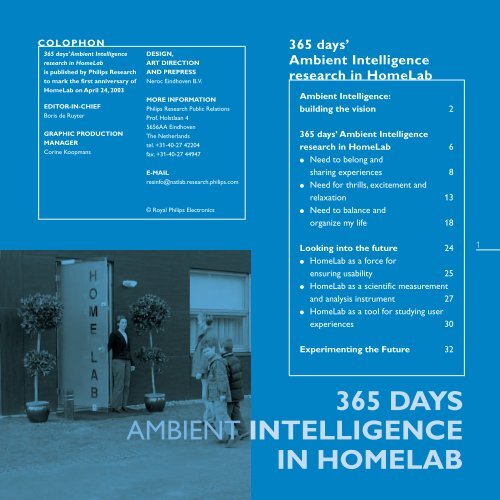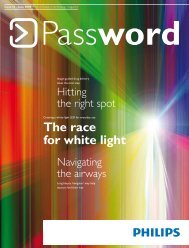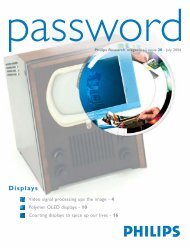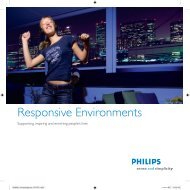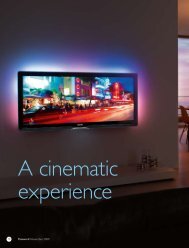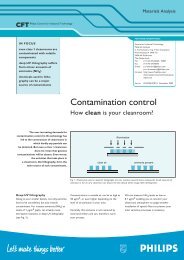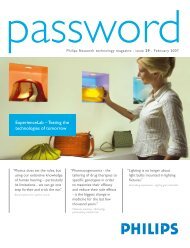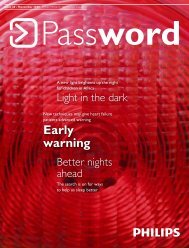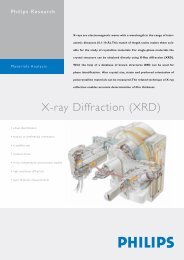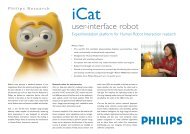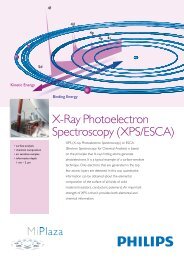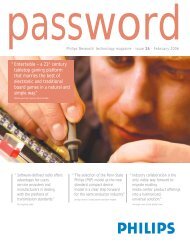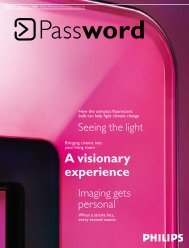365 DAYS AMBIENT INTELLIGENCE IN HOMELAB - Philips Research
365 DAYS AMBIENT INTELLIGENCE IN HOMELAB - Philips Research
365 DAYS AMBIENT INTELLIGENCE IN HOMELAB - Philips Research
Create successful ePaper yourself
Turn your PDF publications into a flip-book with our unique Google optimized e-Paper software.
Ambient 05-05-2003 12:35 Pagina 1<br />
COLOPHON<br />
<strong>365</strong> days’Ambient Intelligence<br />
research in HomeLab<br />
is published by <strong>Philips</strong> <strong>Research</strong><br />
to mark the first anniversary of<br />
HomeLab on April 24, 2003<br />
EDITOR-<strong>IN</strong>-CHIEF<br />
Boris de Ruyter<br />
GRAPHIC PRODUCTION<br />
MANAGER<br />
Corine Koopmans<br />
DESIGN,<br />
ART DIRECTION<br />
AND PREPRESS<br />
Neroc Eindhoven B.V.<br />
MORE <strong>IN</strong>FORMATION<br />
<strong>Philips</strong> <strong>Research</strong> Public Relations<br />
Prof. Holstlaan 4<br />
5656AA Eindhoven<br />
The Netherlands<br />
tel. +31-40-27 42204<br />
fax. +31-40-27 44947<br />
E-MAIL<br />
resinfo@natlab.research.philips.com<br />
© Royal <strong>Philips</strong> Electronics<br />
<strong>365</strong> days’<br />
Ambient Intelligence<br />
research in HomeLab<br />
Ambient Intelligence:<br />
building the vision 2<br />
<strong>365</strong> days’ Ambient Intelligence<br />
research in HomeLab 6<br />
● Need to belong and<br />
sharing experiences 8<br />
● Need for thrills, excitement and<br />
relaxation 13<br />
● Need to balance and<br />
organize my life 18<br />
Looking into the future 24<br />
● HomeLab as a force for<br />
ensuring usability 25<br />
● HomeLab as a scientific measurement<br />
and analysis instrument 27<br />
● HomeLab as a tool for studying user<br />
experiences 30<br />
1<br />
Experimenting the Future 32<br />
<strong>365</strong> <strong>DAYS</strong><br />
<strong>AMBIENT</strong> <strong><strong>IN</strong>TELLIGENCE</strong><br />
<strong>IN</strong> <strong>HOMELAB</strong>
Ambient 05-05-2003 12:35 Pagina 2<br />
Ambient Intelligence:<br />
BUILD<strong>IN</strong>G THE VISION<br />
Emile Aarts , <strong>Philips</strong> <strong>Research</strong><br />
2<br />
After <strong>365</strong> days of intensive research in<br />
HomeLab it is time to take a break and<br />
step back for a moment to have a look at<br />
what has happened with the vision of<br />
Ambient Intelligence and to see how it has<br />
developed over time. Clearly, the concept of<br />
Ambient Intelligence did not come into<br />
being overnight. It took quite some time to<br />
formulate it and shape it into a mature<br />
vision that could not only govern research<br />
and development processes within <strong>Philips</strong>,<br />
but also have an impact on the company’s<br />
product portfolio and marketing strategy.<br />
The notion of Ambient Intelligence was<br />
proposed in 1998 in a series of workshops<br />
that were organized within <strong>Philips</strong>, and that<br />
were commissioned by the Board of the<br />
Management [Zelka, 1998]. The workshops<br />
were aimed at developing different scenarios<br />
that would lead a high-volume consumer<br />
electronics industry from the current world,<br />
which was called fragmented with features,<br />
into a world near 2020 with fully integrated<br />
user-friendly devices supporting ubiquitous<br />
information, communication and entertainment.<br />
Palo Alto Ventures, a US management<br />
consultancy company, acted as the facilitator,<br />
and they involved several <strong>Philips</strong> departments<br />
including <strong>Research</strong>, Design and<br />
Global Brand Management.<br />
The workshops coincided with a number of<br />
worldwide developments from which it can<br />
be concluded in hindsight that the time was<br />
right for developing a vision like Ambient<br />
Intelligence. Let me mention just two of<br />
them. Firstly, performance
Ambient 05-05-2003 12:35 Pagina 3<br />
indicators of semiconductor circuitry, such as<br />
computing power, communication bandwidth,<br />
storage capacity, power dissipation and<br />
integration density, revealed that these quantities<br />
had come within ranges that allowed<br />
electronics to be integrate into any possible<br />
physical object like clothes, furniture, cars<br />
and homes, thus making people’s environments<br />
smart. Secondly, socio-economic<br />
investigations revealed that a next wave of<br />
business development was emerging, based<br />
on mass customization and leading to<br />
a new economic order called The<br />
Experience Economy.<br />
Casa Prossima Futura, had managed to<br />
visualize persuasively a world in which the<br />
current demanding consumer products<br />
would be replaced with new products that<br />
support greater ease of use [<strong>Philips</strong> Design,<br />
1996; <strong>Philips</strong> Design, 1999].<br />
In the meantime the vision matured. In<br />
2000 the first serious plans were launched to<br />
build an advanced laboratory that could be<br />
used to conduct feasibility and usability<br />
The first official publication that<br />
mentions the notion “Ambient<br />
Intelligence” appeared in a Dutch IT<br />
journal [Aarts & Appelo, 1999] and<br />
emphasized the importance of the<br />
early work of the late Mark Weiser,<br />
who had been working for more<br />
than ten years already on a new concept<br />
for mobile computing which he<br />
called ubiquitous computing [Weiser, 1991].<br />
From a technological point of view this<br />
concept has been very influential and it<br />
can be viewed as the starting point for<br />
several new developments, including IBM’s<br />
pervasive computing and <strong>Philips</strong>’ Ambient<br />
Intelligence.<br />
From the point of view of industrial design<br />
we need to mention the work of <strong>Philips</strong><br />
Design, who, through a number of large<br />
projects such as Vision of the Future and La<br />
studies in Ambient Intelligence. After two<br />
years of design and construction, HomeLab<br />
was opened on April 24, 2002 by Gerard<br />
Kleisterlee, the president of <strong>Philips</strong><br />
Electronics. On the occasion of the opening<br />
an international technology seminar was<br />
held and a booklet published explaining the<br />
purpose and the ambition of HomeLab<br />
[Aarts & Eggen, 2002]. The opening event<br />
officially marked the start of the Ambient<br />
Intelligence research in HomeLab. Since<br />
then HomeLab has attracted much attention<br />
➜<br />
3
Ambient 05-05-2003 12:35 Pagina 4<br />
4<br />
from the press. In less than a year it was featured<br />
on television, including Discovery<br />
Channel, more than 25 times, and more<br />
than 100 press articles have been published<br />
in a large variety of journals ranging from<br />
Focus to The Wall Street Journal. More than<br />
150 visits to HomeLab were organized and<br />
it has become a real challenge to ensure that<br />
HomeLab adheres to its original objective of<br />
being a research facility, because there is a<br />
continuous and natural pressure to turn it<br />
into a showcase.<br />
Along with the development of the vision<br />
for <strong>Philips</strong>, a parallel track was followed<br />
which was aimed at positioning the vision as<br />
an open initiative for the advancement of<br />
innovation in information and communication<br />
technology in Europe.<br />
During a series of workgroups organized by<br />
ISTAG (Information Society and<br />
Technology Advisory Group), which serves<br />
as an influential advisory board to the<br />
European Community, the vision of<br />
Ambient Intelligence was adopted as the<br />
leading theme for the sixth framework on<br />
IST research in Europe [ISTAG, 2001]. This<br />
major achievement will result in a subsidiary<br />
European research program with a budget of<br />
EUR 3.7 billion over the coming four years,<br />
focused on research in the domain of<br />
Ambient Intelligence.<br />
At the same time the vision was recognized<br />
as one of the leading themes in computing<br />
science by the Association for Computing<br />
Machinery (ACM), and as a result a chapter<br />
on Ambient Intelligence was included in the<br />
book The Invisible Future [Aarts, Harwig &<br />
Schuurmans, 2001]. The book was published<br />
on the occasion of the ACM1 conference,<br />
which was aimed at providing the electrical<br />
engineering and computer science community<br />
of the world with new insights into the<br />
future of computing. In addition to the chapter<br />
on Ambient Intelligence the book contains<br />
a wealth of contributions from various<br />
renowned scientist expressing their vision on<br />
a variety of subjects ranging from computer<br />
hardware and programming through to<br />
health, education and social issues.<br />
The Ambient Intelligence vision has also<br />
been used by <strong>Philips</strong> <strong>Research</strong> to establish<br />
new and promising collaborations with other<br />
strong players in the field. In 1999 <strong>Philips</strong><br />
<strong>Research</strong> joined the Oxygen alliance, an<br />
international consortium of industrial<br />
partners that collaborated within the context<br />
of the MIT Oxygen project. The Oxygen<br />
project is a joint effort of the MIT Computer<br />
Science Laboratory and the Artificial<br />
Intelligence Laboratory, and it is aimed at<br />
developing the technology for the computer<br />
of the 21 st century [Dertouzos, 1999].<br />
It allows multi-modal controlled handheld<br />
communication units to connect through<br />
environmental units to a broadband<br />
communication network, thus supporting<br />
ubiquitous information access and<br />
communication. Several technological
Ambient 05-05-2003 12:35 Pagina 5<br />
results obtained in the Oxygen project have<br />
found their way to HomeLab. Examples<br />
include the Cricket location detection technology<br />
and speech and vision technologies.<br />
Another example of an international<br />
Ambient Intelligence-based activity is the<br />
joint virtual laboratory that was established<br />
in 2000. The activity involves <strong>Philips</strong><br />
<strong>Research</strong>, <strong>IN</strong>RIA and Thomson Multimedia<br />
in a project called Ambient Intelligence<br />
<strong>Research</strong> and Development (AIR&D), and<br />
is aimed at developing software platforms<br />
for Ambient Intelligence applications in the<br />
home. This project has proved quite successful<br />
and first results have become available to<br />
HomeLab in the form of middleware supporting<br />
intelligent broadband services.<br />
In the summer of 2002 <strong>Philips</strong> Design and<br />
<strong>Philips</strong> <strong>Research</strong> launched a joint project<br />
aimed at producing a book on Ambient<br />
Intelligence. The book should consolidate<br />
the position of <strong>Philips</strong> as the intellectual<br />
leader in the field of Ambient Intelligence.<br />
On March 1 st , 2003 The New Everyday was<br />
published [Aarts & Marzano, 2003]. The<br />
book contains over 100 contributions on<br />
Ambient Intelligence, on a broad range of<br />
topics ranging from materials science<br />
through to marketing and business models.<br />
Most of the contributions are from <strong>Philips</strong><br />
authors, but about ten are from renowned<br />
specialists on various aspects ranging from<br />
promising new applications to warnings of<br />
the possible social disorientation that might<br />
result from Ambient Intelligence. The book<br />
is a unique object because it covers the subject<br />
of Ambient Intelligence from a remarkably<br />
broad perspective, thus providing a solid<br />
basis for future discussions of the subject.<br />
After five years of steady development we<br />
can safely state that the Ambient Intelligence<br />
vision has reached a well-recognized status<br />
of maturity. It has been adopted by <strong>Philips</strong><br />
as a strategy for the company, and it has<br />
been recognized by the European<br />
Commission as a research directive for the<br />
IST 6 th Framework. Both inside and outside<br />
<strong>Philips</strong> the development of the vision will<br />
continue and HomeLab will play a prominent<br />
role in the studies on feasibility and<br />
usability aspects of Ambient Intelligence.<br />
We need to continue evangelising the vision<br />
throughout <strong>Philips</strong> and Europe in order to<br />
make it come true.<br />
➜<br />
5
Ambient 05-05-2003 12:36 Pagina 6<br />
<strong>365</strong> days’ Ambient Intelligence<br />
research <strong>IN</strong> <strong>HOMELAB</strong><br />
Boris de Ruyter, <strong>Philips</strong> <strong>Research</strong><br />
6<br />
Studies into the meaning of the home of<br />
the future have revealed that people want<br />
this home of the future to be like the home<br />
of today. Based on in-depth interviews we<br />
discovered that people fear scenarios of the<br />
future in which technology would interfere<br />
with their daily life in the home of the<br />
future. In fact, people expect technology<br />
to become more supportive in the future.<br />
A home is defined in terms of family rituals<br />
such as breakfast and bedtime storytelling.<br />
The biggest challenge for future technology<br />
is thus to be not only physically embedded<br />
but also to be interwoven into the social<br />
context of the home of the future.<br />
During the first year of Ambient Intelligence<br />
research in HomeLab, special attention was
Ambient 05-05-2003 12:36 Pagina 7<br />
devoted to interactive systems that support<br />
three consumer needs:<br />
Need to belong and share<br />
experiences.<br />
As broadband Internet connectivity is<br />
becoming reality, research in HomeLab has<br />
been investigating real user benefits of<br />
bringing connectivity into the home<br />
environment. This research has been<br />
focusing on connectivity as an enabler for<br />
true experiences. <strong>Research</strong> in HomeLab on<br />
enhancing experiences has been focusing<br />
on: (a) using light as a technology to<br />
enhance movie watching and (b) adding<br />
intelligence to a remote control.<br />
Need to balance and organize<br />
my life<br />
With the breakthrough of mass storage<br />
and broadband connectivity, users will get<br />
access to content from different media,<br />
7<br />
(a) supporting the sharing of content and<br />
experiences and (b) creating the feeling of<br />
being together.<br />
Need for thrills, excitement and<br />
relaxation<br />
When people think about the home of the<br />
future, they emphasize that technology<br />
should enable them to maximize their<br />
leisure time. Whenever possible, the<br />
consumption of content should result in<br />
stored at different locations and via different<br />
access devices. <strong>Research</strong> in HomeLab has<br />
been focusing on developing intuitive<br />
navigation concepts that put users in<br />
control.<br />
➜
Ambient 05-05-2003 12:36 Pagina 8<br />
Need to BELONG<strong>IN</strong>G<br />
AND SHARE EXPERIENCES<br />
Leonie Jansen, <strong>Philips</strong> Consumer & Marketing Intelligence<br />
8<br />
Even though individualization is a fact in<br />
today’s society, we still want to be part<br />
of something. There is a strong need to<br />
belong and connect: ME within the collective<br />
WE. With everything around us changing<br />
so fast, we want to be close to people as<br />
a desire for reassurance. With friends and<br />
family we share feelings and experiences,<br />
then they become really special and valuable.<br />
Watching movies or playing games is even<br />
more exciting when doing it together.<br />
Especially among youth, the need for<br />
belonging and sharing experiences is<br />
extremely important. They want to be a<br />
respected member of a tribe. However,<br />
within the boundaries of what is accepted<br />
in the tribe, they want to be recognized as<br />
having their own unique personality.<br />
➜
Ambient 05-05-2003 12:36 Pagina 9<br />
Sharing CONTENT AND<br />
EXPERIENCES<br />
Richard van de Sluis and Mark Verberkt, <strong>Philips</strong> <strong>Research</strong><br />
Hypothesis: People want to share content in a networked home environment<br />
Concept: Virtual places presented on stationary and wireless screens in a networked<br />
environment<br />
9<br />
Result: People loved the concept due to its ease-of-use and saw great opportunities<br />
for sharing self-created content such as photos<br />
One interaction concept that was<br />
developed and tested in HomeLab was<br />
the concept of “spaces”. A “space” can be seen<br />
as a virtual place that allows a group of people<br />
to stay in touch with each other, to share<br />
content and to share experiences. The idea is<br />
that a group of people should be able to create<br />
a space that is accessible for the whole group,<br />
independent of each individual’s physical<br />
location. For example, a family space would be<br />
accessible for all household members from all<br />
over the world, stretching the home beyond<br />
the physical boundaries of the house.<br />
A space contains content items of any type,<br />
such as a TV program, a movie, a music track,<br />
a memo, a video card or a media album.<br />
Besides content sharing, a space can also be<br />
used to meet each other. In a Friends space, for<br />
instance, a few friends could have a chat with<br />
each other using video communication. But<br />
they can also go a step further and start a<br />
so-called “shared activity”. This means that<br />
these friends can also browse through a photo<br />
album together or watch a football match<br />
➜
Ambient 05-05-2003 12:36 Pagina 10<br />
10<br />
together while being in different physical<br />
places. In a shared activity, all users involved<br />
not only have a synchronized view on the<br />
content, they can also see and hear each other.<br />
The user study<br />
The aim of the user test in HomeLab was to<br />
verify if people see significant added value in<br />
this type of sharing and communication. We<br />
invited pairs of family members and pairs of<br />
friends to the test, and let them deliver some<br />
of their personal photos and<br />
music beforehand. The living<br />
room and study were used for<br />
the test. If, for instance, two<br />
friends came to the test their<br />
personal photos and music were<br />
put in their personal space, and<br />
they were asked to share some<br />
of these content items with the<br />
other participant through the<br />
Friends space. In various tasks<br />
they were asked to meet each<br />
other, to browse through a<br />
photo album together, and to watch TV<br />
together using the Friends space.<br />
Results<br />
All participants in the test had a very positive<br />
attitude about the possibilities offered by the<br />
system. Of the various functions, content<br />
sharing is seen as the most important one.<br />
People like the idea because it can be done in<br />
an easy and efficient manner and physical<br />
distance is no longer a factor. All participants<br />
mentioned photos as the most important<br />
content type to be shared, followed by music<br />
and home videos. In general, personal or selfcreated<br />
content plays an important role in<br />
content sharing. The fact that all those<br />
functions can be accessed from the couch in<br />
the living room is seen as an important<br />
advantage. Besides this, the portable display<br />
allows people to move freely through the house<br />
without being restricted to a certain location. It<br />
was mentioned by some participants that the<br />
PC-type interaction is often anti-social, with<br />
one person sitting in front of the PC often<br />
with his back towards others, whereas a<br />
portable display or a wall-mounted display is<br />
more conducive to the social interaction,<br />
allowing people to watch things together.<br />
While participants appreciate the ease of using<br />
the system, some people also mention the fact<br />
that they miss particular functionality. For<br />
instance, the method of exchanging messages is<br />
very limited compared to what is possible on a<br />
PC. It can be concluded that many people like<br />
to have complete PC functionality in their<br />
living rooms, but at the same time they want it<br />
to be very easy to control while leaning back<br />
on the couch.<br />
➜<br />
Insights gained into:<br />
Preferences people have with regard to content<br />
sharing<br />
The role handheld devices can play within the home<br />
environment
Ambient 05-05-2003 12:37 Pagina 11<br />
The feeling<br />
OF BE<strong>IN</strong>G TOGETHER<br />
Boris de Ruyter, <strong>Philips</strong> <strong>Research</strong><br />
Hypothesis: People want to have<br />
the feeling of being together when<br />
physically separated<br />
Concept: Augment TV content with<br />
silhouettes representing movements of<br />
the people in the remote location<br />
Results: Participants enjoyed this<br />
new way of watching TV and had a<br />
strong sense of being together while<br />
preserving their feeling of privacy<br />
The introduction of advanced<br />
technologies such as interactive TV has<br />
not resulted in the expected behavioral<br />
change on the part of consumers. We<br />
contend that one of the most important<br />
reasons for this has been the absence of<br />
sufficient content to offer attractive user<br />
benefits. Consequently our research in the<br />
<strong>Philips</strong> HomeLab explores the potential user<br />
benefits offered by interconnected consumer<br />
electronics devices.<br />
One such benefit is “social presence”, which<br />
is the sensation of “being together” that can<br />
be experienced when people interact<br />
through a telecommunication medium. As<br />
connectivity permeates our daily lives we<br />
expect that network infrastructures will<br />
become enablers of social interaction. While<br />
communication media such as e-mail,<br />
telephony, text messaging, are common,<br />
there is more to system-mediated<br />
communication than exchanging<br />
information.<br />
Our research on the feeling of being<br />
together has been focusing on the potential<br />
to attain social presence by maintaining a<br />
➜<br />
11
Ambient 05-05-2003 12:37 Pagina 12<br />
12<br />
peripheral awareness of a connected person<br />
or group of persons, outside the context of<br />
communication/information exchange tasks.<br />
This research assesses affective benefits that<br />
arise out of this interconnection and<br />
illustrate the positive impact of awareness on<br />
social interactions.<br />
The user study<br />
In total 34 subjects, all Dutch males,<br />
participated in the experiment. They were<br />
recruited as groups of friends who enjoy<br />
watching soccer games. The friends were<br />
split (2-1) and placed in two different<br />
rooms. During the experiment all<br />
participants watched the same soccer game.<br />
The amount of visual information the<br />
subjects received about their friend(s) was<br />
varied over the different conditions and would<br />
range from: no visual information, a sketchlike<br />
visualization representing physical<br />
movements of the people at the remote<br />
location, and a full-motion video of the<br />
remote location. Social presence and group<br />
attraction (i.e. the feeling of being part of a<br />
group) were measured after each condition by<br />
use of standardized psychometric instruments<br />
available in literature.<br />
Results<br />
The results of this study indicate that a lowbandwidth<br />
visualization of the physical<br />
activities at remote locations is capable of<br />
establishing a sense of social presence.<br />
Furthermore, group attraction was<br />
increased. Compared with the full-motion<br />
video, the sketch visualization gave<br />
participants less of a feeling of being<br />
observed by the remote location. This latter<br />
aspect of the sketchy visualization could be<br />
of great importance in creating socialpresence-enabling<br />
systems for the home<br />
environment: earlier research has shown that<br />
privacy considerations are a major obstacle<br />
to the acceptance of video communication<br />
in the home.<br />
Test participants indicated that<br />
they would prefer different<br />
levels of social presence for<br />
different kinds of programs.<br />
People prefer to watch sports<br />
and movies in the presence of<br />
others, whereas they prefer to<br />
watch news and documentaries<br />
alone. They do not want to be<br />
disturbed while concentrating<br />
on the serious programs. For<br />
entertaining programs, viewers<br />
enjoy having a cozy atmosphere and<br />
experiencing other people’s reactions.<br />
Insights gained into:<br />
Mechanisms to provide a feeling of being together<br />
when separated<br />
The relations between content types and the need for<br />
social presence<br />
➜
Ambient 05-05-2003 12:37 Pagina 13<br />
Need for<br />
THRILLS, EXCITEMENT AND<br />
RELAXATION<br />
Leonie Jansen, <strong>Philips</strong> Consumer & Marketing Intelligence<br />
13<br />
There is a strong need to have an intense<br />
sense of being alive, to get away from<br />
the daily hassle, to relax and lose yourself in<br />
the world of entertainment and discovery.<br />
The search for thrill is the result of our everaccelerating<br />
way of living. This is not only<br />
expressed in the desire for extreme experiences<br />
but also appreciation of smaller things.<br />
Consumers seek ways to reward themselves<br />
and to rediscover the magic in everyday life.<br />
The keys to this consumer need lies into the<br />
ability to switch your mood: from a state of<br />
boredom to thrill/ excitement and from<br />
stress to relaxation. Consumers want to<br />
reach their desired state fast, with a minimum<br />
of effort. The need for mood change is<br />
not limited to the boundaries of the home,<br />
also on the go people want to be able to<br />
escape the world around them.<br />
➜
Ambient 05-05-2003 12:37 Pagina 14<br />
Ambient Intelligent Lighting:<br />
LIV<strong>IN</strong>G LIGHT<br />
Elmo Diederiks and Jettie Hoonhout, <strong>Philips</strong> <strong>Research</strong><br />
Hypothesis: Full-colour ambient lighting enhances the experience of watching TV<br />
and listening to music<br />
14<br />
Concept: Living Light<br />
Results: Participants highly appreciated the concept, especially for film.They also<br />
pointed out new application areas and related requirements.<br />
Afavorite leisure activity of many is<br />
watching movies, either in the cinema,<br />
or at home. The way we watch movies at<br />
home has changed considerably since the<br />
first television was introduced: from blackand-white<br />
to full color, from mono to stereo<br />
to surround sound. The next step is now<br />
being developed and tested in the <strong>Philips</strong><br />
HomeLab: the Living Light concept. The<br />
<strong>Philips</strong> Living Light system can be<br />
considered as the next step in the Home<br />
Cinema Experience. It offers light<br />
ambiences and light effects for film and<br />
music. The system comprises four<br />
LightSpeakers (left, right, front, back), a<br />
CenterLight and a SubLight, which is<br />
situated underneath the couch. Light scripts<br />
for selected pieces of film and music have<br />
been developed in conjunction with lighting<br />
designers, theatre lighting experts,<br />
filmmakers and musicians. This system has<br />
been installed in the living room of<br />
HomeLab, to provide the right context for<br />
experiencing this concept.
Ambient 05-05-2003 12:37 Pagina 15<br />
The user study<br />
The concept has been evaluated with specified<br />
user groups, primarily to determine its appeal<br />
in terms of acceptance, usability and<br />
excitement. The secondary purpose was to<br />
collect additional information on possible<br />
improvements of the concept from the point of<br />
view of the user. Also, participants’ opinions<br />
were collected regarding the appropriateness of<br />
the light settings that were presented. The 32<br />
participants were representative of the target<br />
group: they had a keen interest in watching<br />
movies or listening to music at home. Half of<br />
the participants were shown film and the other<br />
half were asked to listen to music, in both cases<br />
enhanced by light ambience settings and light<br />
effects provided by the Living Light system.<br />
Results<br />
The evaluation of the concept indicates that<br />
Living Light is a potential winner as<br />
participants greatly appreciated the concept,<br />
especially in the case of film. Participants<br />
indicated that the system made watching<br />
movies or listening to music a very enjoyable<br />
and a more immersive experience.<br />
In addition, participants indicated that they<br />
would like to use such a system to create the<br />
right ambience in the home, e.g. when having<br />
friends over for dinner or enjoying an evening<br />
at home with the family. Light is seen as a key<br />
factor in creating the right setting and<br />
ambience at home. Current technologies do<br />
not provide sufficient and easy-to-use means to<br />
create the desired light settings. The fact that<br />
the Living Light system offers possibilities to<br />
manipulate for example color temperature and<br />
intensity was therefore highly appreciated.<br />
These findings provide additional directions<br />
for future research: lighting concepts that offer<br />
solutions that take away the hassle of setting up<br />
appropriate lighting, and in addition provide<br />
extra means to enhance activities and create<br />
enjoyable ambiences.<br />
➜<br />
Insights gained into<br />
The appeal of and requirements for the Living Light<br />
concept<br />
User preferences concerning ambience in the home<br />
15
Ambient 05-05-2003 12:37 Pagina 16<br />
Intelligent<br />
REMOTE CONTROLS<br />
Tatiana Lashina, <strong>Philips</strong> <strong>Research</strong><br />
16<br />
Hypothesis: Interactive devices will<br />
bring more value if they take account<br />
of the user’s context when attracting<br />
the user’s attention<br />
Concept: Make a remote control context<br />
aware by adding sensors to perceive<br />
and interpret its context to adapt<br />
the way it attracts the user’s attention<br />
Results: Participants valued context<br />
aware behavior of the device as it<br />
prevented missing reminders and<br />
eliminated irrelevant notifications<br />
In the drive to improve the experience<br />
people get when interacting with a<br />
product we explore novel intelligent<br />
interaction techniques. One such technique<br />
is making a system context-aware so that it<br />
can adapt and react to changes in the<br />
environment. For this, the concept of a<br />
personal remote control (PRC) was<br />
developed. This remote control with a color<br />
touch screen contains an Electronic Program<br />
Guide with a recommender function that<br />
filters a complete listing of programs to only<br />
those matching a user’s personal profile.<br />
With this information, the PRC can remind<br />
users of upcoming programs of interest.<br />
A common problem with conventional<br />
portable devices with an alarm function is<br />
that they either irritate us by disturbing at<br />
the wrong moment or fail to inform us of<br />
events we wanted to be reminded of. We<br />
made the PRC context-aware as we wanted<br />
to avoid such problems. Equipped with a
Ambient 05-05-2003 12:37 Pagina 17<br />
number of sensors, the remote control can<br />
detect contexts such as being in the user’s<br />
hand, lying in a drawer, the user being<br />
around, and so on. With this information,<br />
the remote control changes the way it issues<br />
reminders for upcoming programs that are of<br />
personal importance as indicated by the user.<br />
The user study<br />
An explorative user study was conducted<br />
with the aim of gaining an understanding of<br />
the user-perceived benefits of context-aware<br />
features and the relevancy of context<br />
awareness for specific applications. In order<br />
to involve subjects who where representative<br />
of the potential users, we selected them<br />
according to the following criteria: subjects<br />
had to watch TV on a regular basis, they had<br />
to plan their TV watching at least for the<br />
upcoming evening and not just zap through<br />
the channels, they had to be in the<br />
possession of a mobile phone and have<br />
experience with an electronic agenda and<br />
electronic messaging applications. After<br />
experiencing context awareness, participants<br />
were interviewed. A number of questions in<br />
the interview compared context awareness<br />
usage scenarios of the PRC to those of<br />
mobile phones.<br />
Results<br />
The context-aware features of the PRC were<br />
considered significantly more attractive than<br />
similar features in the context of a<br />
mobile phone. In the interview that<br />
followed the respondents revealed<br />
that missing a reminder is seen to be<br />
a more serious problem than missing<br />
an incoming call since users<br />
themselves install the reminder. Each<br />
usage scenario was analyzed in terms<br />
of the relevancy of the problem<br />
addressed and the attractiveness of<br />
the context-aware solution. All PRC<br />
context-aware features received a<br />
relatively high rating.<br />
Participants in the study were enthusiastic<br />
about the application demonstrated in the<br />
PRC concept and considered it a potential<br />
replacement of the TV guide give the<br />
additional benefits it offers.<br />
Insights gained into:<br />
The perceived user benefits of context awareness<br />
The relevancy of problems addressed by sensor-based<br />
context awareness and the attractiveness of the<br />
context-aware solutions<br />
➜<br />
17
Ambient 05-05-2003 12:38 Pagina 18<br />
Need to BALANCE AND<br />
ORGANIZE MY LIFE<br />
Leonie Jansen, <strong>Philips</strong> Consumer & Marketing Intelligence<br />
18<br />
Our need for organizing comes from the<br />
fact that we have too much to do in<br />
too fast a pace with too little time. To feel in<br />
control we want to bring order into our lives<br />
by organizing time, money and space.<br />
Consumers are striving to find a good balance<br />
between their work/ school life, friends<br />
and family and personal time. This is not<br />
only true for families with children, also<br />
teenagers, young singles and couples experience<br />
time constraints.<br />
They look for solutions that bring more<br />
efficiency and simplicity in every day life,<br />
keep them informed about what interests<br />
them and enable them to take care of their<br />
priorities. These solutions should help them<br />
navigate through life, but they still want to<br />
be in control and they want it to happen at<br />
their terms.<br />
➜
Ambient 05-05-2003 12:38 Pagina 19<br />
Photo browsing in a<br />
SMART ENVIRONMENT<br />
Evert van Loenen and Elise van den Hoven, <strong>Philips</strong> <strong>Research</strong><br />
Hypothesis: People have a need for<br />
Ambient Intelligent products that support<br />
digital photo browsing, and the Memory<br />
Browser concept is suited to meet<br />
that need<br />
Concept: A system that helps people to<br />
navigate their photo collection at any<br />
place in the home in an intuitive manner,<br />
by means of physical objects such as souvenirs<br />
and “drag-and-view” of images to<br />
stationary and portable screens<br />
One of the concepts being studied in<br />
HomeLab is that of Memory Browsing.<br />
The aim is to provide users with natural,<br />
intuitive means to recollect and share<br />
experiences of past events. The motivation for<br />
choosing this concept came from an extensive<br />
user-study into what people find important in<br />
their homes. One of the major conclusions was<br />
that “Photographs are irreplaceable<br />
representatives of memories that people have.<br />
They are the undisputed number one in the<br />
ranks of important objects’. Many people<br />
mention the need to share their memories with<br />
others, for example, by showing them their<br />
photos and telling about the experiences they<br />
had at the time.<br />
19<br />
Results: Users were delighted by the<br />
meaningful navigation concept and device,<br />
and acknowledged the need for it:<br />
“Great, when will it be on the market?’<br />
With the advent of digital photo and video<br />
cameras, recording snapshots of important<br />
events in one’s life has become much easier.<br />
However, retrieving them has not. On the<br />
contrary: the amount of personal content<br />
increases dramatically, and is typically stored<br />
➜
Ambient 05-05-2003 12:38 Pagina 20<br />
20<br />
on a PC which is not located where the photos<br />
are needed. To address these problems, a first<br />
version of a Memory Browser was developed,<br />
which focuses on intuitive retrieval and sharing<br />
of digital photos.<br />
This Photo Browser has the following features:<br />
• It consists of a portable touch-screen device<br />
(‘Sepia’), which is wirelessly connected to a<br />
PC or other storage and processing unit.<br />
This PC with stored photos remains where<br />
it normally is (the study), while the Sepia<br />
can be used anywhere in the home to<br />
retrieve the photos.<br />
• The user interface on a Sepia shows all<br />
available albums in a continuously moving<br />
photo-roll. By touching a particular album,<br />
the photos contained in it are shown in the<br />
roll. These can now be dragged to the center<br />
of the screen to enlarge them. The photo-roll<br />
can be grabbed with a finger or pen, and the<br />
movement can be reversed, accelerated or<br />
stopped at will.<br />
• Other available screens (both fixed and<br />
portable) are shown as icons, and photos can<br />
simply be dragged to an icon for immediate<br />
display on the related screen (‘drag-and-<br />
Vview’). Any screen can be used, provided it<br />
is connected to a device on the home<br />
network that can run a small Java “servant’.<br />
A distributed software platform (‘Empire’)<br />
takes care of discovery and connection of all<br />
available servants in the network.<br />
• The system is location-aware: in HomeLab<br />
the location of each Sepia can be tracked, and<br />
only the screens in the room where the user is<br />
located are shown in the user interface (UI).<br />
This helps to keep the UI free of irrelevant<br />
information.<br />
• Finally, tagged graspable objects can be used<br />
as shortcuts: by placing a souvenir on the<br />
table, the photos associated with this souvenir<br />
are presented instantly in the photo-roll.<br />
The user study<br />
Besides a technical evaluation, a sequence of<br />
user studies was performed. This started with a<br />
focus group on reminiscence,<br />
followed by an expert evaluation<br />
of the UI during the design<br />
process, and an evaluation of<br />
the total system in HomeLab.<br />
Results<br />
After incorporating all lessons<br />
learned in the focus group and<br />
formative evaluation, the total<br />
system was implemented in<br />
HomeLab. Specific attention<br />
was paid to realising a truly<br />
ambient system, i.e. keeping the PC s and<br />
wireless access point outside the living room,<br />
and integrating the RFID-detection system for<br />
the objects in the existing coffee table.<br />
The implemented system works quite well.<br />
The implementation of the Empire platform<br />
proved a major improvement in system<br />
robustness, compared to an earlier<br />
demonstrator based on the commercially<br />
available Jini platform. A tablet PC was<br />
selected initially as an implementation of
Ambient 05-05-2003 12:38 Pagina 21<br />
Sepia, to enable rapid prototyping. Later, it was<br />
demonstrated that the Photo Browser runs<br />
equally well on the <strong>Philips</strong> Detachable<br />
Monitor, albeit with less smoothness in<br />
rendering the moving photo-roll.<br />
For the user evaluation, the Photo Browser has<br />
been demonstrated to many visitors (roughly<br />
2000) since its implementation in HomeLab.<br />
Recurring themes that emerged were:<br />
• Visitors generally recognised the usefulness of<br />
the system immediately: many own a digital<br />
camera, and have encountered the problems<br />
described above themselves: “This is great,<br />
when will it be on the market?’.<br />
• Stimuli for picking up a photo album are<br />
very diverse, ranging from a simple question,<br />
a typical smell or sound, or missing a loved<br />
one badly. Once people are in such a mood,<br />
photo browsing is considered a fulfilling<br />
activity.<br />
• Photo browsing is often characterized as a<br />
social activity. Photos, and the memories they<br />
evoke, are used by people to share<br />
perspectives, consolidate and tighten<br />
relationships, or simply have fun. The<br />
possibility offered by the Photo Browser to<br />
use screens present in the environment for<br />
displaying photos, as well as the option to<br />
instantly access relevant albums by means of<br />
objects, is valued as an enhancement of<br />
photo browsing in a social context.<br />
• People discriminated between two different<br />
contexts of use: an individual setting in<br />
which the experience of remembering is<br />
linked to mood, and a multi-user setting in<br />
which the activity of recollecting memories is<br />
related to telling stories about the past. In<br />
both situations people mainly talk about the<br />
experiences and less about the actual photos.<br />
This seems to indicate that efforts to solve<br />
the problem of how to support the<br />
recollecting of memories should focus on<br />
how the system can optimally trigger the<br />
experience of remembering. To fully explore<br />
this concept we are conducting a large-scale<br />
study in HomeLab, evaluating the power of<br />
photos, smells, sounds, videos and graspable<br />
objects as memory triggers.<br />
Insights gained into:<br />
User needs, wants and wishes related to retrieval and<br />
sharing of memories<br />
System requirements for a product that can fulfill these<br />
Feasibility, usability and appreciation of a first prototype<br />
system, focusing on photo browsing and enabling dragand-view<br />
and use of personal souvenirs.<br />
The authors gratefully acknowledge the other<br />
members of the Phenom team involved in this<br />
work: Nick de Jong, Esko Dijk, Yuechen Qian<br />
and Dario Teixeira.<br />
➜<br />
21
Ambient 05-05-2003 12:38 Pagina 22<br />
Meaningful NAVIGATION<br />
Gerard Hollemans, <strong>Philips</strong> <strong>Research</strong><br />
22<br />
Hypothesis: Navigating large databases<br />
of digital content will be more enjoyable<br />
if the content is consistently organized in<br />
a filter structure<br />
Concept: The MediaBrowser with<br />
consistent navigation for any type of<br />
content and any size of collection using<br />
filtering<br />
Results: Participants expressed that the<br />
MediaBrowser navigation concept offers<br />
strong user benefits for personal digital<br />
content<br />
The concept of the MediaBrowser aims, to<br />
provide people with consistent<br />
interaction for accessing and navigating<br />
photos, music and video content. This<br />
consistency extends not only over types of<br />
content, but also over types of interaction<br />
devices. In addition to content access and<br />
navigation the MediaBrowser offers the user<br />
functionality to bring content into the system,<br />
to organize content, and to enjoy content.<br />
The MediaBrowser enables users to navigate<br />
their content collection. After selecting the<br />
location and the type of content, e.g., audio,<br />
video, or photos, the user can decide to use a<br />
full overview of the content or to use filters to<br />
reduce the list of content to that content that is<br />
related to, e.g., holidays (for photos). Users can<br />
set multiple filters at the same time to reduce a<br />
(potentially very) long list to a browsable list.<br />
To enable the use of filters in the interaction,<br />
metadata needs to be available for the content.<br />
Without the metadata the user will only get a<br />
list of all albums that are available for the<br />
selected content type. The metadata needs to<br />
be provided either by the user or by automatic
Ambient 05-05-2003 12:38 Pagina 23<br />
extraction of metadata from the content<br />
through content analysis by the system. To<br />
support the former option, functionality to<br />
annotate albums and items is included in the<br />
MediaBrowser concept.<br />
The user study<br />
The MediaBrowser was evaluated in a user test<br />
to investigate the use of filters. With real users<br />
the content retrieving styles of filters and<br />
(hierarchical) folders were compared. The aim<br />
was to identify, from a user perspective, the<br />
benefits and possible drawbacks of a filtering<br />
approach. In addition to this, usability aspects<br />
of the MediaBrowser as implemented for a TV<br />
set were investigated.<br />
For the user test the participants brought in<br />
their own content, (a subset of) their collection<br />
of photos with a minimum size of 500 photos.<br />
This in contrast to many studies reported in<br />
the literature, in which users are presented<br />
either with relatively small-sized collections<br />
(around 200 items) and/or with collections<br />
that are not their own, which makes it harder<br />
to give the users realistic tasks that they would<br />
carry out in the context of their own collection.<br />
The participants in the evaluation study were<br />
users who maintain the collection as well as<br />
their partners who also own the collection, but<br />
who do not maintain the collection.<br />
The results<br />
The study led to interesting results. Most<br />
participants hardly ever annotate<br />
individual pictures, and sets of<br />
pictures (analogous to conventional<br />
“albums’) usually only have one<br />
keyword as a description. So,<br />
participants appreciated the extra<br />
entries in the filtering approach,<br />
allowing them to retrieve pictures and<br />
sets of pictures more easily than with<br />
the conventional approach. Even<br />
though this requires some additional<br />
work when bringing new pictures into<br />
the collection, participants thought<br />
that this effort was minimal, manageable<br />
(especially since albums can be annotated,<br />
making it unnecessary to annotate each<br />
individual picture), and certainly worthwhile<br />
the effort, given the benefits of later retrieval<br />
options that are now available.<br />
Insights gained into:<br />
➜<br />
Meaningful content classification mechanisms<br />
Consistent navigation structures for multimedia<br />
content<br />
23
Ambient 05-05-2003 12:38 Pagina 24<br />
Looking into THE FUTURE<br />
Boris de Ruyter, <strong>Philips</strong> <strong>Research</strong><br />
24<br />
An infrastructure such as HomeLab<br />
allows for early user evaluations of<br />
advanced interaction technologies. Given the<br />
system approach advocated by Ambient<br />
Intelligence these user evaluations require<br />
innovative methodologies and measurement<br />
instruments. Established organisations such<br />
as the Usability Professional’s Organisation<br />
have recognised the need for new approaches<br />
to usability testing [Branaghan, 2001].<br />
Moving towards the conceptualisation,<br />
creation and evaluation of user experiences,<br />
there is a growing need for adequate methods<br />
and tools. Usability criteria such as<br />
effectiveness and efficiency are being<br />
enriched by criteria such as user satisfaction<br />
and experiences.<br />
During the first year of usability research in<br />
HomeLab, <strong>Philips</strong> has gained insight into<br />
the operationalisation and measurement of<br />
user experiences. Usability research in<br />
HomeLab has been confronted with<br />
advanced and extensive data logging<br />
mechanisms and, due to the complexity of<br />
data gathered, research in HomeLab has<br />
brought advanced data analysis tools into the<br />
evaluation cycle. With these tools, the<br />
behavioural researcher in HomeLab is now<br />
equipped with data mining instruments that<br />
will reveal hidden behavioural patterns<br />
captured inside HomeLab during<br />
observational studies.<br />
Some of the recognised experts in the area of<br />
usability testing, with whom we have been<br />
working, present their vision on future<br />
challenges for usability research in<br />
HomeLab. From the methodological point<br />
of view, Rex Hartson (Virginia Tech)<br />
expresses some interesting usability research<br />
issues. <strong>Research</strong> challenges with regard to<br />
data collection and analysis instruments are<br />
discussed by Lucas Noldus (Noldus IT). To<br />
conclude, Manfred Tschelig (Center for<br />
Usability <strong>Research</strong> & Engineering) gives his<br />
view on researching user experiences in<br />
HomeLab.<br />
➜
Ambient 05-05-2003 12:38 Pagina 25<br />
HomeLab AS A FORCE<br />
FOR ENSUR<strong>IN</strong>G USABILITY<br />
Prof. Dr Rex Hartson,Virginia Tech., USA<br />
<strong>Philips</strong> has a vision. In an age when so<br />
many others are pursuing technology<br />
just because it is possible, <strong>Philips</strong>, through<br />
its HomeLab, is instead mastering the use of<br />
technology by people. <strong>Philips</strong> is learning<br />
about how people interact with technology,<br />
so they can make <strong>Philips</strong> innovations work<br />
for users.<br />
Many organizations work to include<br />
new technology in their products.That in<br />
itself is easy. Howevere, we are all too<br />
familiar with technology that is frustrating<br />
and difficult to use or that cannot be used in<br />
the ways we want.<br />
How, then, does <strong>Philips</strong> expect to make<br />
technology work for people?<br />
They know that people use technology to<br />
perform tasks to accomplish various goals in<br />
their lives, that the connection between<br />
technology and people is use. It has to work<br />
for them in the context of real use.<br />
How is <strong>Philips</strong> working to understand<br />
technology in this context of use?<br />
The answer is fundamental knowledge that<br />
comes from a multi-disciplinary approach<br />
to the science and engineering of empirical<br />
studies used for technology prototype<br />
testing with real and potential users.<br />
Success hinges on something we call<br />
ecological validity, which simply means that<br />
the context of the engineering studies must<br />
be like the context of real use - exactly what<br />
the <strong>Philips</strong> HomeLab is uniquely qualified<br />
to provide!<br />
HomeLab takes user-centered context<br />
➜<br />
25
Ambient 05-05-2003 12:38 Pagina 26<br />
26<br />
significantly beyond that of the typical<br />
usability-testing lab. HomeLab provides<br />
context for Ambient Intelligence supporting<br />
long-term living in a home - a much richer,<br />
broader and more detailed context to<br />
represent realistically the complexities and<br />
subtleties of daily human living.<br />
The user’s context for technology has two<br />
parts: the physical, cultural and social<br />
aspects of daily living activities on the one<br />
hand and the interface to technology on the<br />
other. <strong>Philips</strong>’ user-centered engineering is<br />
what bridges that gap; translating from the<br />
user’s cognitive and perceptual language to<br />
the physical language of the controls and<br />
displays of technology. Without this basic<br />
understanding of technology in the context<br />
of use, especially for new technology such as<br />
Ambient Intelligence, <strong>Philips</strong> Design cannot<br />
know for certain if they are making the best<br />
connection between people and technology<br />
in their product designs.<br />
The philosophy that underlies the approach<br />
is a rock-solid user-centered engineering<br />
approach that has already proved itself<br />
effective in human-computer interaction.<br />
Engineers in other organizations where<br />
technology itself is the focus do not see real<br />
users; they don’t see them experience using<br />
technology; they don’t see users struggling<br />
or failing to make the connection of use<br />
with their technology.<br />
Thus, HomeLab plays a pivotal role as the<br />
proof point for <strong>Philips</strong>’ vision of being a<br />
leader in connecting people with technology.<br />
Technology studies in HomeLab allow<br />
<strong>Philips</strong> Design to produce future products<br />
with users who are in control, users who are<br />
satisfied and not frustrated, users who can<br />
focus on normal activities and not on how<br />
to work the technology. Most importantly,<br />
HomeLab will lead to users who don’t even<br />
“see” the technology; they simply perform<br />
their own daily living activities,<br />
unobtrusively aided by ubiquitous,<br />
transparent and intelligent functionality.<br />
➜
Ambient 05-05-2003 12:38 Pagina 27<br />
HomeLab AS A SCIENTIFIC<br />
MEASUREMENT AND<br />
ANALYSIS <strong>IN</strong>STRUMENT<br />
Dr Lucas Noldus, Noldus Information Technology,The Netherlands<br />
Noldus Information Technology<br />
congratulates <strong>Philips</strong> on the<br />
anniversary of their HomeLab. Its attractive<br />
interior and excellent observational facilities<br />
have created a unique “living laboratory” for<br />
research on how people interact with the<br />
technology that may enter their homes in<br />
the future. We see several avenues for<br />
exciting new developments concerning data<br />
collection and analysis in a setting like<br />
HomeLab.<br />
Enhanced data collection<br />
HomeLab allows researchers to capture<br />
behavioral events relevant for a particular study<br />
at any moment during the 24h cycle. Since<br />
people usage patterns may vary significantly at<br />
different times of the day, researchers need to<br />
cover as much of the active period as possible.<br />
Otherwise, important events may be<br />
overlooked. However, in practice the duration<br />
of a test session is limited by the length of time<br />
people want to live in HomeLab, and by the<br />
capabilities of the human observer. With<br />
respect to the latter: long-lasting observations,<br />
especially when important behavioral events<br />
are relatively rare and interspersed with long<br />
periods of little relevant activity, are very<br />
demanding for the observer. This holds for live<br />
observation as well as for post-hoc scoring<br />
from a video recording. Besides the high cost<br />
involved in the many hours of watching and<br />
scoring, observer fatigue will negatively<br />
influence the reliability of the data collected,<br />
not to mention the satisfaction of the observer<br />
him/herself! Therefore, in order to get the most<br />
out of a test session and to facilitate longerlasting<br />
experiments, data collection should be<br />
➜<br />
27
Ambient 05-05-2003 12:38 Pagina 28<br />
28<br />
automated as much as possible.<br />
An obvious way to reduce the data collection<br />
effort is by capturing user-system interaction<br />
automatically using embedded event loggers.<br />
Such programs are already in place for<br />
computer desktop and web applications. The<br />
same approach can be used with mobile<br />
devices (PDAs, mobile phones and<br />
communicators, remote controls), consumer<br />
electronics (e.g. TVs, video and audio<br />
equipment), domestic appliances or any other<br />
device with a user interface that we may find in<br />
the home of the future. The challenge is not so<br />
much the data acquisition, which can be built<br />
into any system, but the intelligent filtering of<br />
the stream of events generated this way, in the<br />
context of the system’s user interface and the<br />
user’s intention.<br />
For studies concerning the behavior of people,<br />
and their use of technology, over extended<br />
periods of time and in different parts of the<br />
home, it may be worthwhile to record their<br />
movements between rooms and inside the<br />
room automatically. When automatically<br />
logging how somebody uses an LCD tablet as<br />
an electronic book, it is relevant to know if<br />
s/he is standing, sitting on a couch or lying on<br />
a bed. Thanks to the miniaturization of<br />
transponders and other positioning devices,<br />
automatic tracking of individuals entering or<br />
leaving rooms becomes a really non-invasive<br />
measurement that does not affect normal<br />
behavior. Movements within a room can be<br />
tracked quite easily with computer vision,<br />
while body postures (e.g. standing, walking,<br />
sitting) can be distinguished using either shape<br />
recognition in digital video images or wearable<br />
sensors. This is not science fiction; these<br />
techniques have been used for many years in<br />
studies of animal behavior, using tools like<br />
EthoVision ® , and have matured to such an<br />
extent that the move into the human domain<br />
has become possible. Experimental<br />
psychologists are now exploiting the<br />
possibilities of computer vision, and there is no<br />
reason why these techniques should not be<br />
used in usability research. Automatic<br />
monitoring of people’s movements and gross<br />
body postures also allows the automated preprocessing<br />
of large quantities of video footage<br />
to extract those episodes where relevant<br />
behavioral events are likely to occur. This way<br />
the human observers can limit their visual<br />
inspection and manual data collection to a<br />
fraction of the video material.<br />
One of the cornerstones of Ambient<br />
Intelligence is the adaptive behavior of systems<br />
in response to the user’s mental or emotional<br />
state. In order to test the performance of such a<br />
system we obviously need to measure the<br />
physiological state of the user before and<br />
during the interaction with the system,<br />
especially if we also want to know if the user’s<br />
state changes in the process. At the risk of<br />
making HomeLab too much like a “real lab”,<br />
one could ask participants to wear a tiny<br />
telemetry device with surface electrodes that<br />
continuously transmits relevant biosignals such<br />
as heart rate, as an indicator of stress or arousal,<br />
to the data collection system. These techniques
Ambient 05-05-2003 12:38 Pagina 29<br />
are commonly used in tests of applications<br />
where the attention of the user is critical (e.g.<br />
control rooms in process industries or air<br />
traffic control, drivers in cars, pilots in aircraft).<br />
Once the sensors and transmitters become<br />
small enough to make them wearable and noninvasive,<br />
these methods may be ready to make<br />
their entry into the usability lab.<br />
Data mining and pattern detection<br />
Enhanced and automated data collection<br />
methods will lead to large data<br />
sets, containing valuable<br />
information awaiting discovery.<br />
When we know what we are<br />
looking for, e.g. if we want to<br />
know how the number of errors<br />
or the time needed to complete<br />
a certain task varies between<br />
several design prototypes of an<br />
appliance, classical frequency<br />
and duration-based statistics<br />
will suffice. However, if we are<br />
exploring sequential aspects of<br />
user-system interaction, different methods are<br />
needed, such as lag sequential analysis, Markov<br />
chain analysis and T-pattern analysis. These<br />
techniques are not new, but they have not been<br />
extensively applied to usability research. They<br />
need to be validated and software tools need to<br />
be developed to make them accessible to<br />
usability testers.<br />
A good example is Theme, a tool capable of<br />
detecting repeated patterns that are hidden to<br />
observers and very hard or impossible to detect<br />
with other available methods. It is particularly<br />
suitable for analyzing behavioral data. Theme<br />
is able to detect patterns that are obscured by<br />
other events, and finds patterns that no form<br />
of frequency count, lag sequential or time<br />
series analysis can identify. As such, it is an<br />
effective way to detect patterns in user-system<br />
interaction and to identify the precursors or<br />
consequences of specific behavioral events.<br />
Theme has been used extensively in studies of<br />
human communication, spoken dialogue,<br />
gestures, protocol analysis, etc. The <strong>Philips</strong><br />
HomeLab is the first corporate user in the<br />
domain of user-system interaction.<br />
To wrap up the tour of new and future tools<br />
for usability testers, a few words about data<br />
visualization. With all the new data collection<br />
and analysis methods coming along, we will be<br />
seeing new graphical methods to visualize user<br />
interaction with systems as well as usability<br />
bottlenecks, with integrated coupling to video<br />
and audio clips and raw data. Such tools will<br />
enable us to take maximum advantage of the<br />
rich information gathered in a laboratory such<br />
as HomeLab.<br />
HomeLab is already an exciting place to work.<br />
I am sure it will be even more so in the<br />
future!<br />
➜<br />
29
Ambient 05-05-2003 12:38 Pagina 30<br />
HomeLab as a tool<br />
FOR STUDY<strong>IN</strong>G USER<br />
EXPERIENCES<br />
Manfred Tschelig, Center for Usability <strong>Research</strong> & Engineering, Germany<br />
30<br />
Intelligence, ubiquity and transparency are<br />
the building blocks of Ambient<br />
Intelligence. Every single element of the<br />
Ambient Intelligence vision of supporting<br />
people’s lives in different contects has to do<br />
with people. People with different<br />
backgrounds, with different needs and<br />
specific communication behavior. It is<br />
claimed that technology and intelligence will<br />
guide and accompany people during different<br />
phases and situations in their day. Will this be<br />
true? Users and their acceptance of Ambient<br />
Intelligence technology (and their willingness<br />
to invest money, time and patience) will be<br />
the success criteria in the end.<br />
Ambient Intelligence technology delivers a<br />
new level of complexity. Over the years<br />
usability experts have developed knowledge,<br />
guidelines, methodology and tools to<br />
optimize the usability of “traditional”<br />
software and hardware. Neglected or not,<br />
consolidated qualitative and methodological<br />
knowledge is available. This is different for<br />
upcoming Ambient Intelligence systems.<br />
There are no guidelines out there, nor will<br />
there be in the near future. For example,<br />
most usability research environments are not<br />
geared to studing users on the move (even to<br />
studying a user not sitting at an office<br />
workplace or wandering around with his<br />
mobile device within some office space is a<br />
different situation), changing between<br />
contexts, using multiple devices, being<br />
supported by “hidden” intelligence or<br />
solving tasks at different times of the day.<br />
What are the differences in having<br />
intelligence around me immediately after a
Ambient 05-05-2003 12:38 Pagina 31<br />
wake-up call in the morning or in more<br />
relaxed situations in the evening? What<br />
degrees of difference in intelligence would<br />
user groups like to have and what are the<br />
control mechanisms they will request? These<br />
are only some of the questions to be tackled.<br />
There are many more!<br />
Studying the needs of users, anticipating the<br />
interaction requirements based on solid data<br />
and studying the experience in the<br />
interaction with artifacts, the synergy of<br />
artifacts and intelligent environments can<br />
only be accomplished by setting up and<br />
utilizing flexible user-experience study<br />
environments. Environments like HomeLab<br />
are a prerequisite for facing the challenges of<br />
developing user experience knowledge,<br />
which will guide people-oriented product<br />
design. Multidimensional and open study<br />
environments allow research on different<br />
levels: basic interaction research towards<br />
basic understanding of interaction<br />
parameters, and applied interaction research<br />
towards specific artifacts and environments<br />
in different stages of design and<br />
development. Multidimensional means the<br />
possibility to study a multidimensional<br />
combination of user experience factors.<br />
Open means covering all situations, both<br />
those that can be foreseen and those that<br />
cannot. There is an incredible power in<br />
utilizing this type of environment to gain<br />
insights into the behavior of people and feed<br />
these insights into innovation cycles.<br />
Studying the user experience within the<br />
Ambient Intelligence society means coming<br />
up with new methods to obtain these<br />
insights in a variety of situations, to<br />
efficiently integrate these insights, in the<br />
development of new potentials and creation<br />
cycles, and to develop a well-coordinated<br />
knowledge mosaic related to user experience<br />
factors. Knowledge to help us address the<br />
challenge of the upcoming ambient society<br />
is available but fragmented. Strategies are<br />
needed to connect the pieces and develop<br />
well-formulated roadmaps for usageoriented<br />
interaction. Enriched user<br />
experience environments have to be set up<br />
to support the vast amount of data<br />
collection and analysis and the study of the<br />
user experience in context.<br />
If that is done, Ambient Intelligence will<br />
deliver real benefits! If not, will fail!<br />
➜<br />
31
Ambient 05-05-2003 12:39 Pagina 32<br />
Experimenting THE FUTURE<br />
Josephine Green,Trends and Strategy, <strong>Philips</strong> Design<br />
32<br />
What might we want, what might we<br />
find useful and enjoyable, in ten, five<br />
or even two years time? What technologies<br />
will we adopt, and, perhaps more importantly,<br />
what technologies will we not adopt,<br />
in order to live well with one another, ourselves<br />
and our surroundings?<br />
For <strong>Philips</strong>, finding possible answers to these<br />
questions, lie both in its vision of the future<br />
and in experimenting that vision and future.<br />
The <strong>Philips</strong> vision is of a sensitive and<br />
responsive environment where technology is<br />
seamlessly embedded into our everyday surroundings<br />
and is personalized to our specific<br />
needs and wants. We have called it Ambient<br />
Intelligence. Experimenting the future<br />
means exploring with people, in their daily
Ambient 05-05-2003 12:39 Pagina 33<br />
living and activities, ways in which Ambient<br />
Intelligence can facilitate, improve and<br />
enhance their quality of life. For one thing is<br />
certain, before looking for any answers to<br />
these questions, technology only makes<br />
sense if it contributes to improving our<br />
quality of life. For this to happen it has to be<br />
relevant to our ways of living and fit our<br />
personal needs.<br />
In journeying to the future, <strong>Philips</strong><br />
<strong>Research</strong>, <strong>Philips</strong> Design and the users<br />
themselves, work together to experiment<br />
new solutions and new value. A multidisciplinary<br />
team of sociologists, anthropologists,<br />
psychologists, designers and researchers<br />
study and research people as they go about<br />
their daily business. To do this they draw on<br />
established observational, ethnographic and<br />
user research techniques and methods as<br />
well as developing new user research<br />
approaches that actively involve researchers,<br />
designers and users in the process . This<br />
“observational” research is embedded in an<br />
integrated approach that offers a richer<br />
understanding of the complexities of today<br />
People and Trends<br />
The integrated approach draws on the ongoing<br />
research programme into Society,<br />
Cultures and People in <strong>Philips</strong> Design. This<br />
offers the background to thinking up new<br />
qualities for future living and sets the context<br />
in which the research takes place. Let’s take<br />
health for example, the ongoing trends<br />
research looks at how society and individuals<br />
are re-defining the concept of healthcare.<br />
Is it more than not being ill? Is it about wellbeing?<br />
Do different cultures, generations or<br />
gender define it differently? What does this<br />
signify for healthcare in the home and can<br />
our technologies add any value?<br />
To make the content and insights from the<br />
trends research more “manageable”, we cluster<br />
the values and needs that emerge from<br />
our research into different themes, which in<br />
turn act as narratives or “scripts” to help us<br />
think about human focused futures. In<br />
essence these themes represent relatively<br />
clear “clusters” of values, attitudes and concerns<br />
that we believe will be guiding many<br />
people’s lives during the coming decade.<br />
These insights help us think about technology<br />
and Ambient Intelligence and to go<br />
beyond the work paradigm of efficiency,<br />
productivity and performance, so often associated<br />
with technology, towards more “soft”<br />
values concerning the building of relationships<br />
and communities and the enhancement<br />
of the emotions and senses. A couple<br />
of brief examples can hopefully serve to<br />
explain this<br />
Mosaic Living<br />
From linear living we are moving towards<br />
mosaic living, where we de-structure our<br />
lives, exploring different ways of doing<br />
things and indeed different things to do.<br />
This gives the feeling that there are many<br />
opportunities to take advantage of, on the<br />
one hand, but also feelings of stress and<br />
33
Ambient 05-05-2003 12:39 Pagina 34<br />
34<br />
information and/or technology “overload”<br />
on the other. People are caught between the<br />
enthusiasm of the new opportunities and<br />
the desire to effectively juggle their work,<br />
their family and their leisure.<br />
In this context, Ambient Intelligence needs<br />
to help simplify our lives as we look for ways<br />
to cope with complex situations and juggle<br />
our multiple options and commitments?<br />
How can it help us be empowered and not<br />
overpowered –by the vast array of choices<br />
and possibilities we have available. How can<br />
it allow us to access information, communication<br />
and entertainment in a non-intrusive<br />
and natural way, through intuitive interfaces<br />
that are customized to our lives, tastes and<br />
preferences. How can it ensure through<br />
seamless integration and connectivity that we<br />
can get this where and when we want? And<br />
how can we stay in control?<br />
Emotional Feeling<br />
Now that many of our physical needs have<br />
been satisfied, we are turning our attention to<br />
satisfying emotional, aesthetic, sensory and<br />
even spiritual needs, with moments of entertainment<br />
and experience no longer seen as<br />
extraordinary events but very much a part of<br />
everyday life. Entertainment itself is changing.<br />
From theatre and concerts to cinema and<br />
TV, it has tended in the past to involve oneway<br />
communication only, requiring a relatively<br />
passive attitude on the part of the audience.<br />
Now, however, the interactivity made<br />
possible by the Internet and by the digitalisation<br />
of broadcasting is encouraging us to take<br />
a more active part, engaging in “experiences”<br />
rather than simply consuming “products” or<br />
services. As we move beyond consuming to<br />
experiencing we are also looking to co-create<br />
or “customize” the experience according to<br />
our own mood and moment.<br />
How can our vision of Ambient Intelligence<br />
provide us with an environment that helps us<br />
experience more through our senses and<br />
allows us to “create” our own experiences that<br />
we could change over time? Perhaps even<br />
introduce moments of magic and surprise,<br />
helping us to enhance mundane events with<br />
“experiential” moments, stimulating our<br />
imagination and feeding our soul.
Ambient 05-05-2003 12:39 Pagina 35<br />
Caring<br />
Increased mobility, the fragmentation of<br />
family life, and the breakdown of national,<br />
local and community safety nets will<br />
increasingly mean that we will feel a need to<br />
take responsibility for our own welfare.<br />
Popular confidence in the ability or will of<br />
governments or other institutions to care for<br />
them and protect them is waning. Greater<br />
availability of information allows people to<br />
scrutinize the basis of “expert opinions” and<br />
reach their own conclusions. It is also bringing<br />
to light abuses of power that would have<br />
remained hidden in the past. We trust less<br />
and we fear more. We will therefore be<br />
searching for reassurance and guarantees.<br />
Given this we will search for anything that<br />
helps us, nurtures us and keeps us safe. In<br />
other words we shall search for peace of<br />
mind. We will welcome tools that allow us<br />
to monitor the health of ourselves or our<br />
loved ones, that allow quick links with<br />
emergency services, or “tag” our children so<br />
that we know where they are. In short how<br />
can our technologies look after us and our<br />
environments rather than us looking after<br />
out technology<br />
In essence our research into society and culture<br />
at a more abstract level and our research<br />
with people at a more concrete level have<br />
one purpose. To ensure that our vision of<br />
Ambient Intelligence and our solutions for<br />
the future are not only socially relevant and<br />
culturally specific but also individually<br />
meaningful. That is the challenge but it is in<br />
the challenge that we also see the way forward.<br />
In the final analysis relevancy and<br />
meaningfullness can only be achieved by<br />
involving users at all stages of the innovation<br />
process: in the research, in the concept<br />
creation and in the development of the<br />
actual solutions. Users and researchers need<br />
to create Ambient Intelligence together<br />
through hands on experimentation and<br />
through trial and error. This is what we<br />
mean by experimenting the future. Home<br />
Lab is one avenue to this end.<br />
➜<br />
35
Ambient 05-05-2003 12:39 Pagina 36<br />
References<br />
36<br />
Aarts E. and Appelo, L. (1999),<br />
Ambient Intelligence: thuisomgevingen<br />
van de toekomst, IT Monitor 9/99,<br />
pp. 7-11.<br />
Aarts, E., Harwig, R. , and<br />
Schuurmans, M. (2001),<br />
Ambient Intelligence, in: P. Denning,<br />
The Invisible Future, McGraw Hill,<br />
New York, pp. 235-250.<br />
Aarts, E., and Eggen, B. (editors) (2002),<br />
Ambient Intelligence in HomeLab, Neroc<br />
Eindhoven,The Netherlands.<br />
Dertouzos, M. (1999),The Future<br />
of Computing, Scientific American<br />
281(2), 52-55.<br />
ISTAG (2001), Scenarios for Ambient<br />
Intelligence, European Commission,<br />
www.cordis.lu/ist/istag.html.<br />
<strong>Philips</strong> Design (1996), Vision of the<br />
Future,V+K Publishing, Bussum,<br />
The Netherlands.<br />
<strong>Philips</strong> Design (1996), La Casa Prossima<br />
Futura, <strong>Philips</strong> Design,The Netherlands.<br />
Aarts, E., and Marzano, S. (editors)<br />
(2003),The New Everyday: Vision on<br />
Ambient Intelligence,<br />
010 Publishers, Rotterdam,<br />
The Netherlands.<br />
Branaghan, R.J, (2001), Design by<br />
people for people: essays on usability,<br />
Usability Professional’s Association.<br />
Weiser, M. (1991),The computer for<br />
the twenty-first century, Scientific<br />
American 265(3), 94 -104.<br />
Zelkha, E. (1998), The Future of<br />
Information Appliances and Consumer<br />
Devices, Palo Alto Ventures, Palo Alto,<br />
California, (unpublished document).


